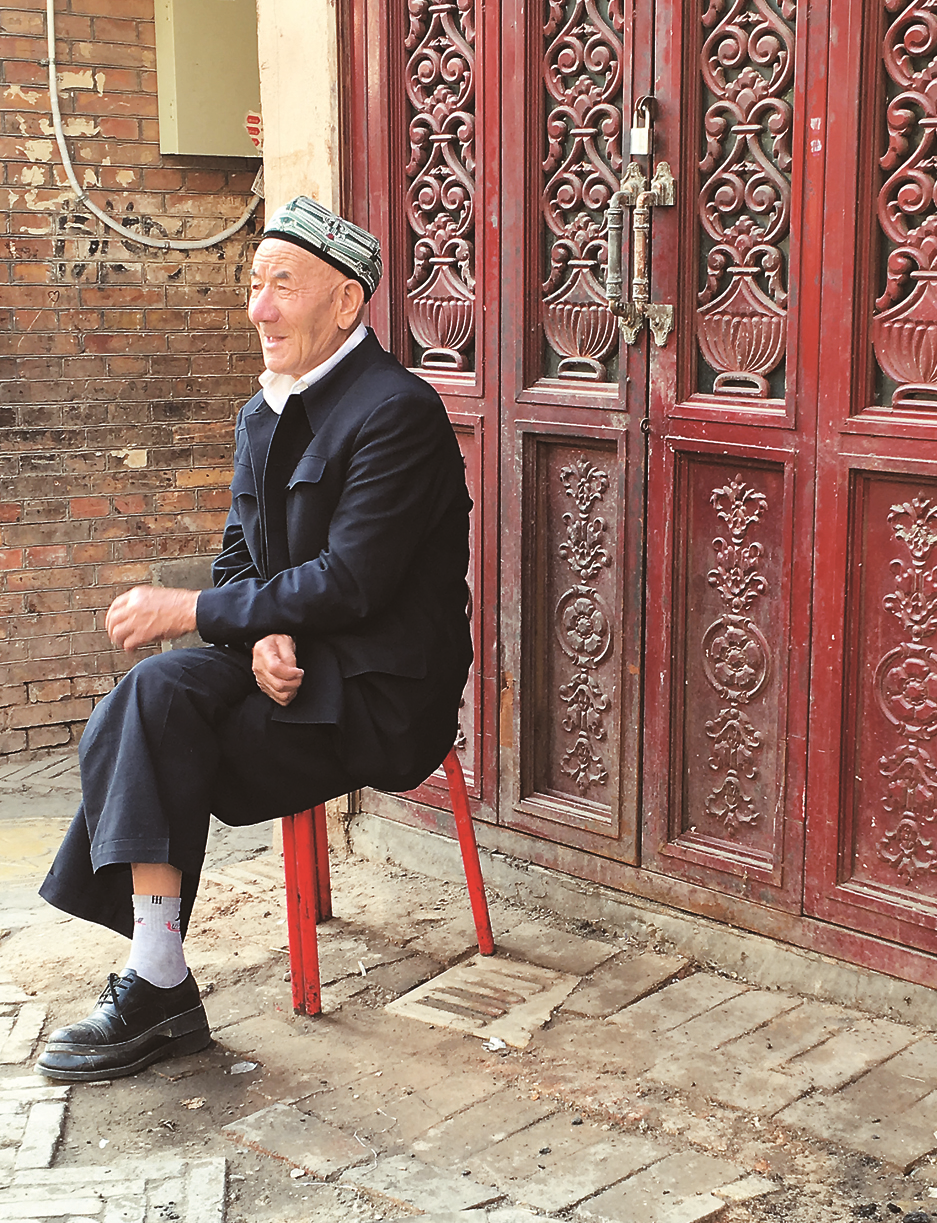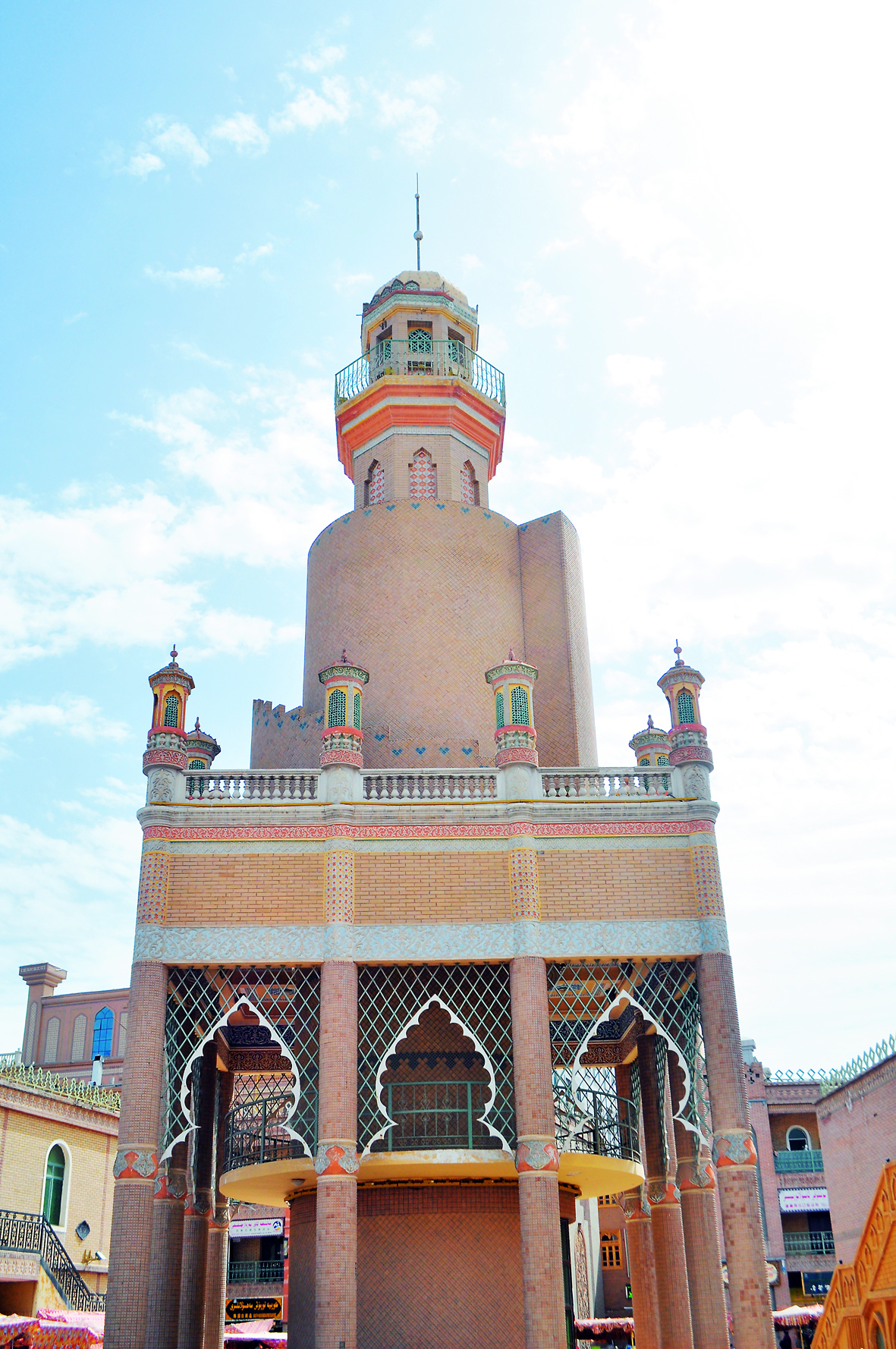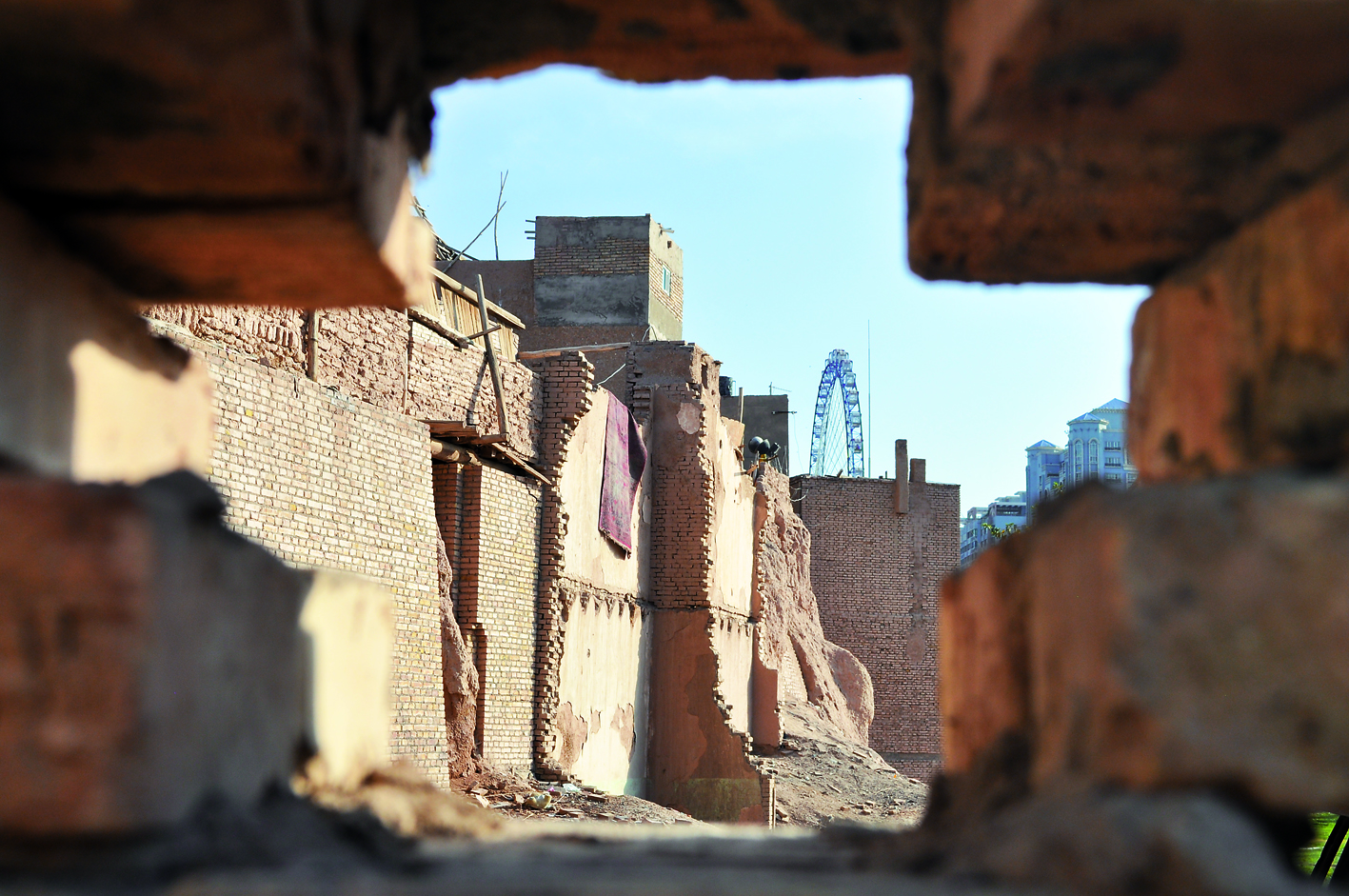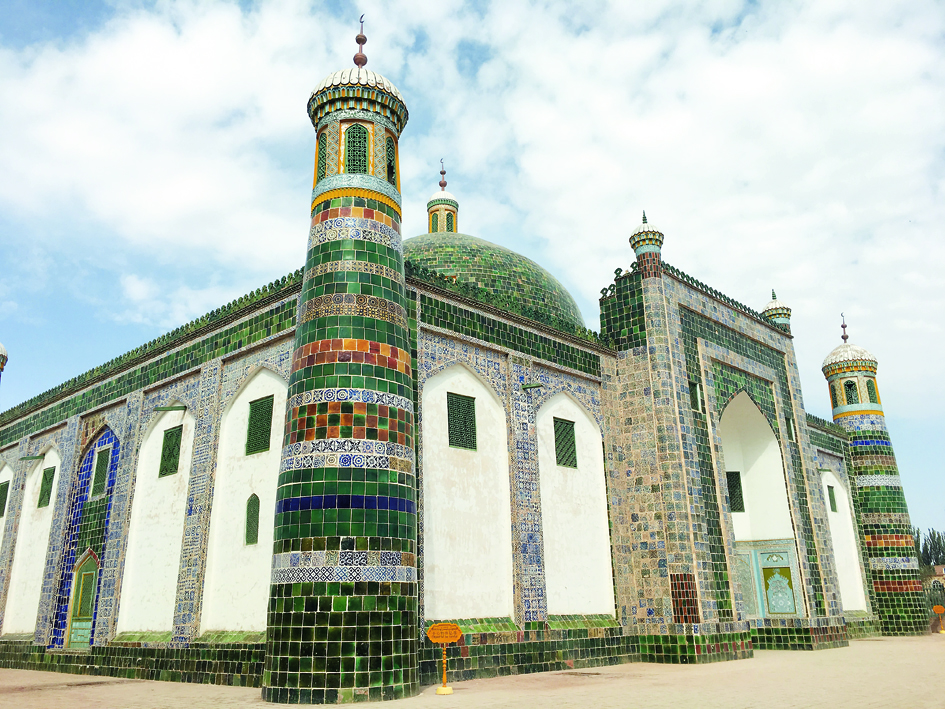Kashgar's resplendent past survives in redevelopment

Id Kah Mosque, built in 1442, is the largest mosque in China.
The dawn crow of roosters, the shouts of street hawkers, the hum of rhythmic chants and the aroma of pancakes and mutton ...
Awakening in the exotic city of Kashgar, I felt the buzz of excitement and the pull of adventure far from my hometown of Shanghai.
Welcome to China’s westernmost city in the Xinjiang Uygur Autonomous Region near the borders with Kyrgyzstan and Tajikistan. It is home to about 500,000 people, most of them ethnic Uygurs of the Muslim faith.
Backpackers are fond of saying that “you will not know how big China if you don’t go to Xinjiang, and you will not know how beautiful Xinjiang is if you don’t visit Kashgar.”
I had no idea how true this was until I came to this tantalizing land.
Kashgar stands against the holy Tianshan and Kunlun mountains, and connects with the magnificent Pamirs and the massive Taklamakan Desert.
History and civilization converge and flourish here.
In the Uygur language, Kashgar means “gathering place of jade.” That reflects its importance as a trading outpost and oasis along the Silk Road that connected China with Central Asia and Europe.
It’s the birthplace of the Uygur culture, and even today, more than 90 percent of inhabitants here are Uygur.
“If you’ve been to the Old City and the bazaar, you don’t need to go to Afghanistan or Iran,” said our driver Abu.
He has every reason to be so proud of his city. A stroll through the labyrinth of alleys in the Old City is like a book on Uygur culture come alive. You can easily spend a whole day there — meandering through the maze of narrow lanes, stopping to try the local ice cream, viewing artworks at an ethnic gallery, chatting with an elderly Uygur or pausing to play with local children.

A young child plays in a tricycle on a side street in the Old City.

An elderly Uygur man, wearing a typical green doppa, enjoys a bit of sunshine in the Old City.
This is the soul of Kashgar.
Here, you don’t need to speak a single word of Uygur. Smiles are the common language. Whenever I waved at people with a Mandarin nihao (hello), they waved back, beaming with hospitality. From toddlers to octogenarians, I was greeted with sincere warmth everywhere I went.
It’s a different world and a totally different experience from life in Shanghai — different even from what I had expected. People are friendlier, clothing is more colorful, streets are cleaner and even the nan (the Central Asian-style baked flatbread) tastes different.
Elderly Uygur men, wearing the typical green doppa, a four- or five-cornered embroidered cap, gathered in small groups, chatting and enjoying a bit of autumn sunshine. Although in some regions of China, a green hat symbolizes betrayal, here it signifies seniority and prestige.
Children as young as three were playing with a tricycle parked on a side street. When I lifted my camera and said “hello” to them, they looked up and immediately broke into smiles, happy to pose for me.
When I bid them farewell, they ran up to me, touching my hand and saying zaijian (bye). At that moment, I no longer felt like a stranger, but rather like one of the family.
Kashgar has undergone dramatic changes from its dusty, forgotten-in-time past. In five years, the Old City was renovated. Dilapidated earth-brick housing, prey to earthquakes and weather erosion, was rehabilitated. Sewage and garbage disposal systems were installed, and flush toilets provided.
In 2010, amid controversy about preserving the cultural heritage of the Uygur people and their ancestral land, a 7-billion-yuan (US$1.1 billion) renovation project was initiated, targeting tumbledown houses in 27 districts and nearly 50,000 households. It wasn’t a cookie-cutter style of redevelopment. Rather, every household had its own distinctive design plan.
Houses were reinforced, roads widened, backstreets asphalted, fire lanes opened, infrastructure expanded and improvement made in hygienic conditions and the quality of drinking water.

Ethnic details in the Old City have been faithfullly preserved after the renovation project, such as the facade, the dome and the patterns.
Now, the main street of Old City is neatly lined with various shops selling distinctive local products — from freshly baked savory pancakes to colorful handicrafts, such as gourds and woolen blankets. Ethnic Uygur music can be heard everywhere, and the smell of spices permeates the air.
Ethnic details have been faithfully preserved. Many storefronts are painted with scenes depicting the Old City. At the end of the main street, a piece of the old city wall remains intact.
Away from the main street, rows of two-story houses stand, decorated by relief artwork, statues and flowers. The houses are painted in different colors. Some are grouped in specialized neighborhoods — blanket street, doppa street, handicraft street and ironware street.
Adili, 63, has lived in the region for decades. He was among the first group of residents affected by the local version of urban renewal.
He moved from a rundown home into a new house in October 2015.
It’s a two-story structure with plenty of room for the six-member family. A spacious living room features a 2-meter-long tea table covered with dishes of jujubes, a Xinjiang traditional food, and fruits. Guests are greeted with great hospitality.

Built on a small loess highland, the mud-brick houses in Gaotai Ancient Homes area are old and sometimes crumbling.
Ancient homes
To experience unadulterated Uygur culture, visitors head to the southeastern section of Old City, in an area known as the Gaotai Ancient Homes. Here people live in a maze of adobe homes in scenes dating back 600 years.
Built on a small loess highland, the mud-brick houses here are indeed old and sometimes crumbling, and modern conveniences are scare. Plans to upgrade the area call for preserving much of it as a sort of heritage park, retaining its historic look to show future generations how Kashgar Old City was before modernization.
About 600 mud-brick houses have been tied to the highland cliff for generations. They are diverse, with a variety of internal structures. For every new generation, a new floor was added to the original base of a dwelling.
The area has been a dense mishmash for centuries. Tourists can easily get lost in the maze of alleys, where lanes may be as narrow as 1.5 meters, impossible for emergency vehicles to navigate should the need arise.
Unlike the cacophony of Old City, there’s no hustle and bustle here. The streets are quiet. People keep to themselves. Bicycles, not mopeds, predominate. Normal stores are a rarity. Vendors sell small commodities and vegetables from the back of flatbed tricycles.
Walking up the slope, visitors bump into children walking home from school or Uygur women sitting by their doors sewing.
One young girl was anxious to show us her home, a shabby mud-brick dwelling built on the slope. It was actually a home-cum-shop where her mother, holding a baby, warmly welcomed us and offered petty crafts for sale. The house had a big terrace with a panoramic view over the surrounding area.
Many families in the Gaotai Ancient Homes area operate small businesses from their houses.
“But if you see a door half-closed, that means the owner is not home,” said our guide. “Do not go inside, especially the guys, or you could find yourself in trouble.”
A panoply of sights and sounds to explore
Grand Bazaar
The word for “bazaar” in the Uygur language means “market and trading place.” At present, there are more than 20 large bazaars in Kashgar. The largest, located at the East Gate of the Old City, is also called the International Trade Market of Central and Western Asia.
Zhang Qian, a diplomat in the Han Dynasty (206 BC-AD 220) dispatched by the imperial court to survey western regions, was amazed to find dazzling goods and merchants from different countries.
Today, the Grand Bazaar is a bustling hive of stalls overflowing with Uygur goods, including doppa (the square or round skullcaps), local food specialties, ornamental knives, elaborately woven silks, patterned printed fabric, earthenware, ceramic pots and vases, an assortment of traditional jewelry, and instruments unique to the region.
If you don’t want to buy something you have been examining, put your right hand on your heart and say, “I think I’ll leave it. Thank you anyway.”

Abakh Khoja Tomb is an ancient Islamic building with glazed tiles and a tower.
Abakh Khoja Tomb
This resting place of a Uygur concubine who was one of Qing Dynasty (1644-1911) Emperor Qianlong’s 41 wives is nestled among poplar trees. The tomb, five kilometers northeast of Kashgar, is an ancient Islamic building with glazed tiles and a tower.
Built from 1640, the tomb has a large rectangular courtyard with a gate tower, worship halls, a doctrine-teaching hall and tomb chamber. The walls and the dome are covered with green glazed tiles. Colored patterns and Arabic words dot the four sides. There are 58 tombs here for five generations in the Abakh Khoja family. All coffins are draped in gorgeous silk and satin. The stone coffin of the concubine lies inconspicuously in the southeast corner.
In other parts of China, the tomb is better known as the Tomb of Xiang Fei, or the Fragrant Concubine. Legend has it that Iparhan, a descendant of Abakh Khoja, gave off an enchanting fragrance without using any perfume, hence the name Xiang Fei.
She spent 28 years with the emperor in Beijing, abiding strictly by Islamic doctrines. Before her death at 55, she expressed the desire to be buried in her hometown in what is now Xinjiang. The emperor so loved her that he had a coffin filled with her clothes sent to Kashgar.
According to archeological findings, her real tomb is in the Eastern Qing Tombs near Beijing.
Open: 8:50am-8pm
Admission: 30 yuan
Id Kah Mosque
Built in 1442, this mosque is the largest in China, with capacity to accommodate up to 22,000 people. Its name means “place of prayer and festivities.”
The building is a marriage of Uygur arts and Islamic features, with a resplendent sunflower-yellow facade. It comprises a main gate, the main prayer hall, an outer building, a hall for doctrine teaching, a courtyard, a dome and minarets.
In the big courtyard, poplars reach skyward and pines grow vigorously. The whole yard is heavily shaded, making it comfortable in summer. A pond of limpid water reflects the green trees that surround it.
The hall of prayer, in the west end of the mosque, is supported by blue pillars in the shape of a rectangle. Exquisite carvings adorn the pillars and roof.
Here, Uygur men sit and pray. A simple chair with a stand for the Koran is provided for elderly worshippers who have difficulties sitting on the ground.
Open: 8:50-10am
Admission: 20 yuan

Nan is the staple food in Kashgar.
How to get there:
It takes a daunting eight hours by air to travel from Shanghai to Kashgar, including a stopover in the Xinjiang capital of Urumqi. Upon arrival at the Kashgar airport, take shuttle bus (5 yuan) or taxi (15 yuan) to downtown, which is about 10 kilometers away. Both the Old City and Gaotai Ancient Homes are in the downtown area.
Tips:
1. Although all parts of China adhere to the single standard of Beijing time, the people in Xinjiang follow their own timetable. By the sun, that’s about two hours behind Beijing time. Lunch in Xinjiang usually starts at 2pm, while dinner is eaten no earlier than 8pm, Beijing time.
2. Pork is off the menu in this predominantly Muslim city.
3. Respect the local culture. Avoid visiting the mosque when rituals or prays are underway. Take off shoes before entering a mosque, and don’t wear vests or shorts. For women, skirts should be below the knee. Once inside, remain quiet.
4. Ask for permission before taking photos of local people. Do not photograph worshipers praying in mosques.
5. Don’t give snacks to local Uygur children unless you are sure they contain no pork-related ingredients. Candies and chocolate are fine.
6. Must-try local specialties include lamb kebabs, polu (literally “grabbed rice”), dapanji (a spicy chicken stew), roast fish and soups made from lamb or chicken.















